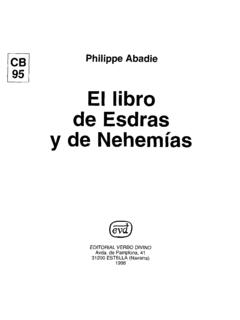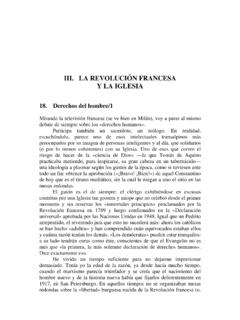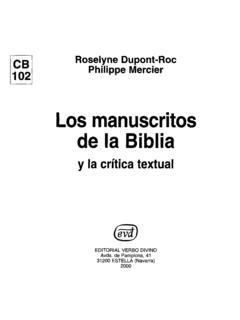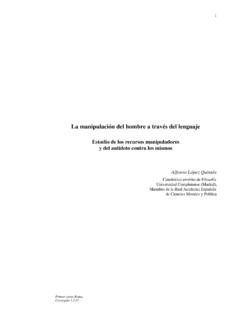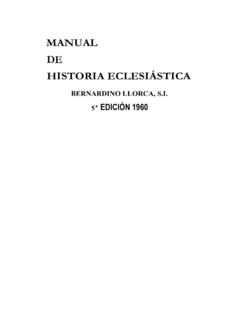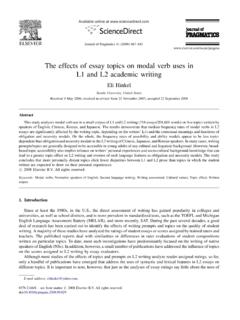Transcription of Basic Italian: A Grammar and Workbook - MERCABA
1 Basic Italian: A Grammar AND WORKBOOKB asic italian : A Grammar and Workbook comprises an accessiblereference Grammar and related exercises in a single Workbook presents 23 individual Grammar points in lively andrealistic contexts. Each unit consists of jargon-free explanations andcomparisons with English, targeting the more common difficulties experi-enced by learners of italian . Grammar points are followed by examplesand exercises selected to make use of contemporary italian introduces italian culture and people through the medium ofthe language used today, providing readers with the Basic tools toexpress themselves in a wide variety of include: examples in both italian and English Grammar tables for easy reference full exercise answer key glossary of grammatical termsBasic italian is the ideal reference and practice book for beginners andalso for students with some knowledge of the Peyronel is a lecturer at the University of Turin, Italy.
2 She hastaught italian to foreigners for over 20 years and is the author ofseveral italian grammars. Ian Higgins is Honorary Senior Lecturer at theUniversity of St Andrews and is co-author of Thinking italian titles available in the Grammar Workbooks series are: Basic CantoneseIntermediate CantoneseBasic ChineseIntermediate ChineseBasic GermanIntermediate GermanBasic PolishIntermediate PolishBasic RussianIntermediate RussianBasic WelshIntermediate WelshTitles of related interest published by Routledge:Colloquial italian , Second Editionby Sylvia LymberyModern italian Grammar : A Practical Guide, Second Editionby Anna Proudfoot and Francesco CardoModern italian Grammar Workbook , Second Editionby Anna ProudfootBASIC Italian: A Grammar ANDWORKBOOKS tella Peyronel and Ian HigginsFirst published 2006by Routledge2 Park Square, Milton Park, Abingdon OX14 4RN, UKSimultaneously published in the USA and Canadaby Routledge270 Madison Ave, New York, NY 10016 Routledge is an imprint of the Taylor & Francis Group 2006 Stella Peyronel and Ian HigginsAll rights reserved.
3 No part of this book may be reprintedor reproduced or utilized in any form or by any electronic, mechanical,or other means, now known or hereafter invented, includingphotocopying and recording, or in any information storage orretrieval system, without permission in writing from the Library Cataloguing in Publication DataA catalogue record for this book is available from the British LibraryLibrary of Congress Cataloging in Publication DataA catalog record for this book has been requestedISBN 0 415 34717 3 This edition published in the Taylor & Francis e-Library, 2005. To purchase your own copy of this or any of Taylor & Francis or Routledge scollection of thousands of eBooks please go to ISBN 0-203-64007-1 Master e-book ISBN(Print Edition)CONTENTSI ntroductionviiList of signs and abbreviationsviii1 Nouns: gender and number12 Definite and indefinite articles93 Adjectives; possessive and demonstrative pronouns174 The present tense of essere and avere285 The present tense of regular (and some irregular) verbs366 Adverbs467 Direct object pronouns (1)528 Prepositions579 Questions6810 Indirect object pronouns (1)7411 Piacere and similar verbs7912 The present perfect tense8413 Direct and indirect object pronouns (2)9414 Direct and indirect object pronouns (3: stressed forms)9915 Relative pronouns10416 The imperfect tense11117 The pronouns ne and ci12018 The future tense12919 The past perfect tense13720 Reflexive pronouns14321 The imperative14922 The pronoun si15723 The present conditional162 Key to exercises168 Glossary of technical terms187 Index191vi ContentsINTRODUCTIONIf you are an English-speaking learner preparing GCSE, Scottish StandardGrade (credit level) or similar examination, or simply learning the languagefor everyday use, this Grammar and Workbook is for you.
4 You will typically beeither following a course at school, college or evening class, or teaching your-self from a published course. This book is not itself a course, but a self-helpreference/revision Grammar , with exercises designed to reinforce your graspof the points dealt with, unit by unit. You will find it a help to have access to agood italian English dictionary when working through the this is not a self-contained course, the Grammar points are usuallygiven on their own, out of context. Of course, this is artificial, because, ineveryday life, when we say or write something it is always in a situation orcontext. To compensate for this artificiality, the Grammar points are illus-trated with abundant examples, which are often reused, with variations,under different headings. This is partly to strengthen your grasp of grammarand vocabulary, but mostly to help you learn how to manipulate the Italianlanguage in a wide range of situations.
5 Giving plenty of examples is a moreeffective way of helping you develop the ability to communicate in Italianthan giving you lists of rules with just one or two the end of each unit, there are several sets of exercises. If you workthrough these, you will find that they consolidate your understanding of thevarious points introduced in the unit, and also that they give you the con-fidence to have a go at expressing yourself in a range of situations aim of the examples and exercises is to strengthen awareness of thespecific points dealt with in the unit; they are not intended to cover all thepossible uses of a given word or grammatical the end of the book, there is a key to all the exercises, and a glossary ofgrammatical terms, with AND ABBREVIATIONS ffemininefpfeminine pluralfsfeminine pluralmsmasculine singularSquare brackets indicate an explanatory comment attached to an example, Luisa al s Luisa on the phone.
6 [ she has just rung]Quanto zucchero [ms] vuoi?How much sugar do you want? Dov Anna? No lo so. Where s Anna? I don t know. [lit. I don t know it]Round brackets in an example show that the material in brackets is optional, Hai i libri? S , (ce) li ho. Have you got the books? Ye s , I ve got them. Ne ho mangiati due. I ate two (of them).A chi scrivete? Who(m) are you writing to?Round brackets round an entire sentence show that, while possible, this is aformal form that is not often used, ( (Loro) Partono, Signori Bianco?)Are you leaving(, Mr and MrsBianco)?A slash shows alternative ways of saying something, dico/Dico loro la verit . I tell them the truth. (Here, gli dico and dicoloro are alternative ways of saying I tell them .)Non mi sembra giusto. It doesn t seem fair to me/I don t think it s fair.(Here, the English sentences are alternatives to one another.)Signs and abbreviations ixUNIT ONEN ouns: gender and numberGender: masculine and feminine1 All italian nouns are either masculine or feminine.
7 The best way to remem-ber the gender of a noun is to learn it along with its definite article ( theword meaning the ). In this unit, nouns will therefore be given along withtheir definite articles, but there will be no discussion of the articles as and indefinite articles are the subject of Unit nouns in the singular end in -o, -a, or italian nouns ending in -o are usually masculine:3 italian nouns ending in -a are usually feminine:4 italian nouns ending in -e can be either masculine or feminine. Unless anoun ending in -e denotes a person whose gender is defined ( husband , wife ), there are virtually no rules to determine its gender, which must there-fore be learned by heart or checked in a dictionary:l uomo [m]il fratello [m]il pomeriggio [m]il treno [m]manbrotherafternoontrainla donna [f]la sorella [f]la sera [f]la bicicletta [f]womansistereveningbicycleTo help you to determine the gender of some nouns ending in -e, here is arule: nouns ending in -sione or -zione are feminine:Sometimes, the gender of a noun ending in -e can be determined by thegender of the person it refers to: masculine when it refers to a male, femininewhen it refers to a female:5 Some nouns ending in -a and referring to persons are masculine when theyrefer to a male and feminine when they refer to a female:** There are some exceptions.
8 La persona (person) and la guida (touristguide) are always feminine, even when they refer to a male, while the feminineof il poeta (poet) is la There are some nouns ending in -a which are masculine and some nounsending in -o which are feminine:Masculineil padreil ristoranteil saleil cognomefatherrestaurantsaltsurnameFemini nela madrela nottela lucela chiavemothernightlightkeyla televisione [f]la pensione [f]la produzione [f]la stazione [f]televisionpensionproductionstationil/ la cantante [m/f]il/la cliente [m/f]il/la parente [m/f]l inglese [m/f](male/female) singer(male/female) customer(male/female) relativeEnglishman/Englishwomanil/la collega [m/f]l atleta [m/f]il/la batterista [m/f]il/la pianista [m/f](male/female) colleague(male/female) athlete(male/female) drummer(male/female) pianistMasculineil cinemail pap il problemacinemadadproblemFemininel autola fotola manocarphotohand2 Unit 1 Some nouns of this type are abbreviations, and have kept the gender of thefull word: cinema stands for cinematografo [m], auto for automobile [f], fotofor fotografia [f], etc.
9 Such cases apart, there is no rule for determining gender,which has to be learned by heart or checked in a Some nouns end in -i. The vast majority are feminine, but there aresome exceptions:Two exceptions are l alibi (alibi) and lo sci (ski), which are Foreign nouns, unless they refer to a female, are generally masculine:9 Occasionally, the gender of a foreign noun is the same as it is for thecorresponding italian word:la new wave is feminine, because onda (wave) is mail (e-mail message) is feminine, because posta (mail) is The following rules can help in determining the gender of nouns: All months of the year and days of the week are masculine, apart fromdomenica (Sunday), which is feminine. All names of towns and cities are feminine, apart from Il Cairo [m]. All names of languages are masculine. Names of countries are normally feminine when they end in -a andmasculine when they end in any other letter:l analisi [f]l ipotesi [f]la crisi [f]analysishypothesiscrisisil bar [m]il camion [m]il rock [m]l hostess [f]barlorryrock (music)stewardessla Francia [f]la Spagna [f]il Belgio [m]il Paraguay [m]FranceSpainBelgiumParaguayUnit 1 3 Number: singular and plural11 Masculine nouns ending in -o, and all nouns ending in -e, end in -i in theplural:* Nouns ending in -ie have only one -i in the Nouns ending in -io have only one i in the plural.
10 But if the -i is stressed(-io), the plural has two (-ii):13 Feminine nouns ending in -a take -e in the plural:14 Masculine nouns ending in -a take -i in the plural:15 When a noun ending in -a denotes a person, its plural ending depends onwhether it is masculine or feminine. If it refers to a male, the plural ends in -i;if it refers to a female, the plural ends in -e:Singularil treno [m]il nome [m]la notte [f]la stazione [f]la pensione [f]il/la parente [m/f]la moglie [f]trainname/nounnightstationpensionrela tivewifePlurali trenii nomile nottile stazionile pensionii/le parentile mogli*trainsnames/nounsnightsstationspen sionsrelativeswivesSingularil bacio [m]il desiderio [m]l inizio [m]lo zio [m]il mormorio [m]kisswishbeginningunclemurmurPlurali bacii desiderigli inizigli ziii mormoriikisseswishesbeginningsunclesmurm ursSingularla sorella [f]la lettera [f]la sera [f]sisterlettereveningPluralle sorellele letterele seresistersletterseveningsSingularil problema [m]il sistema [m]problemsystemPlurali problemii sistemiproblemssystems4 Unit 1* For an explanation of the -h- in these endings, see paragraph 20 Nouns ending in -i do not change in the plural:17 Foreign nouns, and nouns stressed on the last vowel, do not change in theplural.
